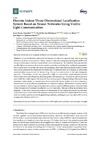Please use this identifier to cite or link to this item:
https://accedacris.ulpgc.es/jspui/handle/10553/41884
| Title: | Discrete Indoor three-dimensional localization system based on neural networks using visible light communication | Authors: | Alonso-González, Itziar Sanchez-Rodriguez, David Ley-Bosch, Carlos Quintana-Suarez, Miguel A. |
UNESCO Clasification: | 3325 Tecnología de las telecomunicaciones 3307 Tecnología electrónica |
Keywords: | Indoor localization Neural network Visible light communication Received signal strength |
Issue Date: | 2018 | Publisher: | 1424-8220 | Journal: | Sensors | Abstract: | Indoor localization estimation has become an attractive research topic due to growing interest in location-aware services. Many research works have proposed solving this problem by using wireless communication systems based on radiofrequency. Nevertheless, those approaches usually deliver an accuracy of up to two metres, since they are hindered by multipath propagation. On the other hand, in the last few years, the increasing use of light-emitting diodes in illumination systems has provided the emergence of Visible Light Communication technologies, in which data communication is performed by transmitting through the visible band of the electromagnetic spectrum. This brings a brand new approach to high accuracy indoor positioning because this kind of network is not affected by electromagnetic interferences and the received optical power is more stable than radio signals. Our research focus on to propose a fingerprinting indoor positioning estimation system based on neural networks to predict the device position in a 3D environment. Neural networks are an effective classification and predictive method. The localization system is built using a dataset of received signal strength coming from a grid of different points. From the these values, the position in Cartesian coordinates (x, y, z) is estimated. The use of three neural networks is proposed in this work, where each network is responsible for estimating the position by each axis. Experimental results indicate that the proposed system leads to substantial improvements to accuracy over the widely-used traditional fingerprinting methods, yielding an accuracy above 99% and an average error distance of 0.4 mm. | URI: | https://accedacris.ulpgc.es/handle/10553/41884 | ISSN: | 1424-8220 | DOI: | 10.3390/s18041040 | Source: | Sensors [ISSN 1424-8220], v. 18 (4), 1040 |
| Appears in Collections: | Artículos |
SCOPUSTM
Citations
44
checked on Jun 8, 2025
WEB OF SCIENCETM
Citations
40
checked on Jun 8, 2025
Page view(s)
71
checked on Oct 14, 2023
Download(s)
103
checked on Oct 14, 2023
Google ScholarTM
Check
Altmetric
Share
Export metadata
Items in accedaCRIS are protected by copyright, with all rights reserved, unless otherwise indicated.
